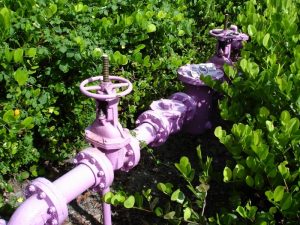
Reclaimed water, or recycled water, is wastewater that has been treated to remove all solids, bacteria, and pathogens. Most often it is used for recharging groundwater supplies, for industrial purposes such as cooling towers, for agricultural and commercial irrigation, and for firefighting, and its use is increasing exponentially, with purple pipes dotting the landscape of our nation. Recycled water is also being used in some incredibly creative ways, and we’ve highlighted five innovative uses for reclaimed water below.
Algae
Algae are considered a potent source of biofuel and are also used extensively in the cosmetics and nutritional supplements industries. Since growing algae commercially requires chemical fertilization, it is frequently considered unviable and prohibitively expensive. Chemical fertilizers significantly cut into profits and they are also needed for more crucial crops, making traditional algae growth unsustainable. Fortunately, some scientists from Rice University in Houston, Texas have found a way to grow algae in municipal wastewater. The wastewater already contains lots of natural, free fertilizer, and the algae actually help to purify the water.
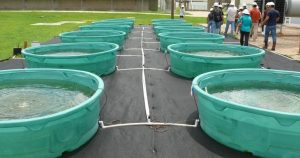
In the study, the scientists found that strains of choice, valuable, oil-rich algae grew and thrived in open-air pools of municipal wastewater that had previously undergone solids removal, while at the same time removing more than 90% of nitrates and 50% of phosphorus from the wastewater. Typically, when too many nitrates and phosphorus remain in treated wastewater, environmental issues such as algae blooms and drinking water contamination can occur. And since there is currently no cost-effective way to remove large quantities of nitrates or phosphorus from water, growing algae in wastewater actually provides significant benefit to municipal wastewater treatment plants. It’s a win-win.
International Space Station
93% of all water on board the International Space Station (ISS) is reclaimed from several sources, including breath and sweat condensate, shower runoff, urine from animals — and, on the American side of the station, multi-national human urine. You see, the Russians don’t recycle their urine, but the Americans do. And, not wanting to waste any resources, the Americans also collect urine from the Russian side and purify that as well.
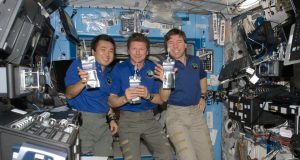
“It tastes like bottled water,” said Layne Carter, water subsystem manager for the ISS at NASA’s Marshall Space Flight Center. “As long as you can psychologically get past the point that it’s recycled urine and condensate that comes out of the air.”
Not only do the Americans and Russians disagree on urine reclamation, they also disagree on purification methods. The Russians utilize silver in its ionic form, and Americans use iodine, although there are plans to switch to silver since it doesn’t need to be filtered from the water prior to consumption. However, Carter believes it is smart for the two nations to employ differing purification methods aboard the station.
“It really makes a lot of sense to have dissimilar redundancies in the space station in case one of the systems has problems,” noted Carter.
The ISS does keep around 2,000 liters of backup water in case of an emergency, but Americans don’t want to take any chances. Speaking on recycling their Russian colleagues’ urine, Carter explains, “We collect it in bags, and then the crew hauls it over to the US side. We don’t do 100% of the Russian urine. It depends on our time availability.”
Canadian astronaut Chris Hadfield produced a video while he was on board ISS in 2013, and in it he defends the consumption of reclaimed water, including urine.
“Before you cringe at the thought of drinking your leftover wash water and your leftover urine, keep in mind that the water that we end up with is purer than most of the water that you drink at home,” he said. “That makes the International Space Station its own self-contained environment. That’s a critical step towards living for long periods off of planet Earth.”
Drinking Water
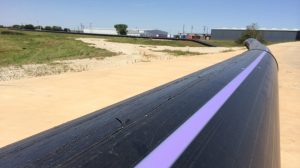
Last year, the then drought-stricken city of Wichita Falls, Texas built a 12.5-mile pipeline that connected its wastewater treatment plant directly to the Cypress Water Treatment Plant, where wastewater was purified into drinking water. At the time, Wichita Falls was suffering from its worst drought on record, with its lakes hovering at an alarming 23%, and the wastewater treatment plant supplied anywhere from 30-50% of demand per day. And while some residents initially opposed the idea, they quickly adapted to the idea of drinking recycled water — after all, there was little choice.
“The water coming out of our wastewater treatment plant is actually cleaner than the lake water it will be mixed with,” said Daniel Nix, Utility Operations Manager for the City of Wichita Falls. He added that the wastewater is highly treated through a four-step process prior to being piped to the drinking water treatment plant where it is then mixed with lake water — and highly treated again.
In July, Wichita Falls was able to stop supplementing its drinking water supply with treated wastewater, as much of Texas experienced heavy rains in the spring that restored lakes and reservoirs almost to capacity. The City now has a drought-proof backup plan that will allow residents and officials to rest a little easier.
Beer
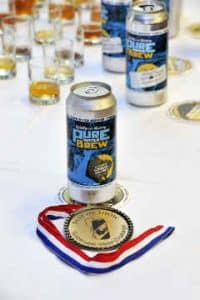
A very adventurous group of home beer brewers known as the Oregon Brew Crew received approval from the state of Oregon to utilize 100% recycled sewage water to brew beer for its 2015 Sustainable Water Challenge/Pure Water Brew competition. Clean Water Services, a wastewater treatment utility that serves the Portland, Oregon metro area, supplied 300 gallons of reclaimed water from its Forest Grove facility to 25 Oregon Brew Crew members in June, and the home brewing enthusiasts set to work. The competition was held on August 29 at the Raccoon Lodge and Brew Pub in Beaverton, Oregon, with Dean Ehnes winning Best In Show, and the grand prize of $100, for his German Pilsner. Ehnes’ brew, along with the other winners, were showcased at the WateReuse Symposium in Seattle and the Water Environment Federation Conference in Chicago, both held this past September.
Although the Oregon Brew Crew received approval to use reclaimed water for their homebrew competition, direct potable reuse is prohibited in Oregon. Many proponents of recycled water usage would like to see that change, and think craft beer is one of the quickest and easiest ways to capture the public’s attention and support. Clean Water Services utilizes advanced treatment processes including ultrafiltration, reverse osmosis, and advanced oxidation to ensure the water is clean and pure.
Mark Jockers, a spokesman for Clean Water Services, stated, “We need to be judging water by its quality, and not by its history. The water we’re producing is significantly cleaner than what the safe drinking standards are for water that comes out of taps across the United States.”
And when it comes to the “yuck factor” associated with water reuse, Zachary Dorsey of the WateReuse Association, a nonprofit that supports water recycling, sums it up nicely: “We all live downstream from someone.”
NFL Football
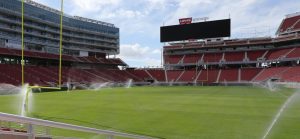
With California in the midst of one of the worst droughts in its history, it’s no surprise that Levi’s® Stadium, the new stadium for the San Francisco 49ers, is the first NFL stadium to receive a LEED Gold rating from the U.S. Green Building Council. Opened in 2014, the stadium boasts such green features as a 27,000 square foot green roof, energy efficient systems, solar power, and the use of almost exclusively recycled construction materials. Recycled water also plays a huge part in the stadium’s sustainability, with about 85% of all water use coming in the form of recycled water from the City of Santa Clara Water and Sewer Utilities. The reclaimed water is used for playing field irrigation, flushing toilets, cooling towers, and of course, watering the enormous green roof!
The stadium has been very well received, and sets a high bar for other stadiums across the nation to follow suit. Unfortunately for 49ers football fans, the stadium has not helped their team, who is currently in dead last place in the NFL standings.
In Conclusion
As we continue to face ever increasing challenges on our water supply including higher demand, failing infrastructure, population growth, climate change, and drought, individuals and communities are increasingly viewing wastewater as a resource rather than a waste product. Continuing to find unique and practical applications for water reuse will both foster greater public acceptance and protect our most precious resource, paving the way for a sustainable future — a benefit on which we can all agree.
